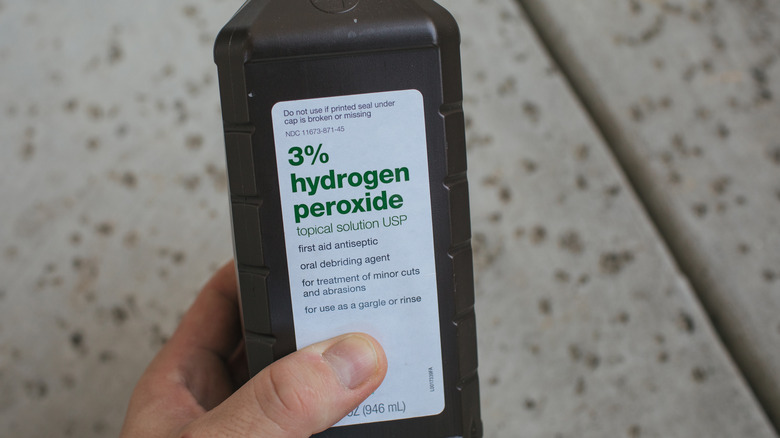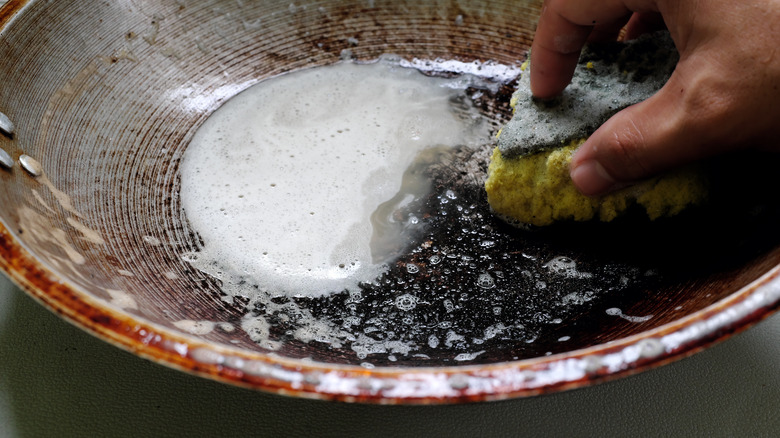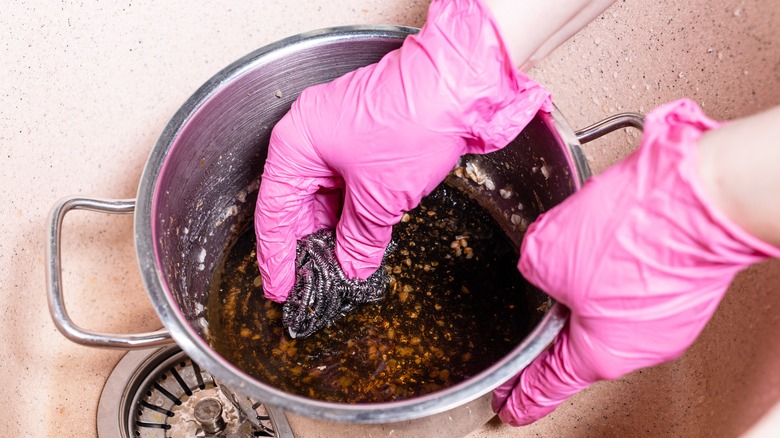Banish Stuck-On Food Stains From Your Pots And Pans With This Liquid Household Essential
Everyone who prepares meals eventually makes an error and burns something. Depending on the level of scorching, you may end up with food stuck to the pots and pans that does not come off in the dishwasher. You don't want to continue cooking with these pans, as you could increase the chance of having the charred residue start an unintentional grease fire the next time you use it. The charred residue also may make the food taste funny the next time you cook in the pot. The new food could even pick up charred flakes from the old burned-on food. (Gross!) You do not have to discard the pan or pot with the burned-on residue, though. You can remove the residue safely and efficiently with help from a household essential; hydrogen peroxide.
You may already know that hydrogen peroxide helps you get rid of stubborn household stains. Most people may focus on using hydrogen peroxide on laundry and bed sheets to remove stubborn stains but it also works nicely on your kitchen utensils and cookware. Hydrogen peroxide should be safe to use on nearly all non-stick cookware, which isn't the case with some other methods of removing stuck-on food.
Before using any household cleansing items on your pots and pans, you should always check with the manufacturer's recommendations. If the manufacturer suggests following certain techniques or using certain cleansing products, try those first. If they don't work, you then can try some other options, like using hydrogen peroxide.
How to use hydrogen peroxide to clean cookware
Compared to some of the other materials and techniques you can use to successfully clean burnt pots and pans, hydrogen peroxide can be easier to use. For example, having to use a lot of effort scrubbing with a sponge or with steel wool can be quite tiring and, ultimately, may not work all that well.
For the first option, pour hydrogen peroxide into the pot or pan until it's about ½ inch in depth. Add about ¼ cup of baking soda and wait for the fizzing reaction to stop. You then can place the cookware on the stove and boil the mixture. (If you don't have any baking soda available, you can add a few squirts of liquid dish soap to the hydrogen peroxide before bringing it to a boil.) Immediately remove it from the heat and let it sit for up to 30 minutes. Use a spoon to try to loosen or break up the burned-on food as it sits. Repeat the boiling process as needed to remove all the food.
If you prefer not to boil it, or if the burned-on food is higher on the surface than the one-half inch of hydrogen peroxide will reach, you have another option. Add the liquid up to the point of the highest level of stuck food. Sprinkle in the baking soda and just let the mixture sit for several hours. The burned-on mess should lift away.
Is it safe to use hydrogen peroxide to clean stuck-on food from pots and pans?
Hydrogen peroxide is a natural substance, as this molecule consists of two hydrogen atoms and two oxygen atoms. That's one extra oxygen atom versus the common water molecule. You can use hydrogen peroxide on most types of cookware safely, with a few exceptions. For example, don't use anything but water to soak and clean a cast iron pan that has food burned on it. (You shouldn't even use soap on cast iron pans.)
It's perfectly safe for people to work around hydrogen peroxide as long as it is in a 3% concentration that's common with household products. Far stronger concentrations are possible when using hydrogen peroxide in industrial settings or medical settings. Food-grade concentrations are typically 35%, for example.
You may want to wear gloves and eye protection when cleaning with 3% hydrogen peroxide. Significant skin contact with a 3% concentration can irritate the skin. If it gets in your eyes, you may have temporary pain and irritation. You may notice respiratory irritation if you inhale the 3% concentration, so avoid directly breathing in the fumes as you work. Severe injuries are possible with higher concentrations of this substance than the 3% sold for use in households. "Food-grade peroxide can be toxic if you inhale it or get it on your skin," Dr. Sarah Pickering Beers told Cleveland Clinic. "And that high strength isn't necessary for cleaning and disinfecting."


